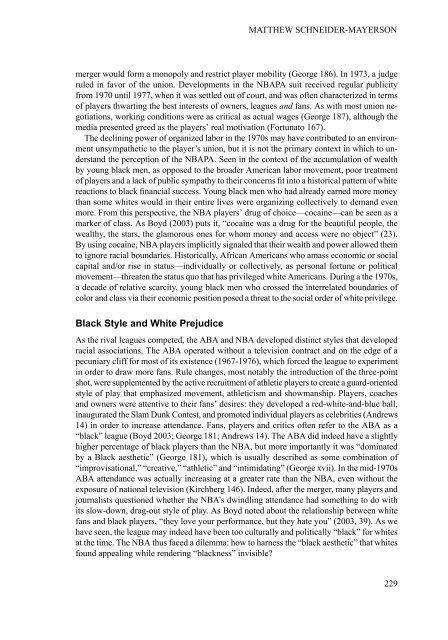Download - University of Minnesota
Download - University of Minnesota
Download - University of Minnesota
Create successful ePaper yourself
Turn your PDF publications into a flip-book with our unique Google optimized e-Paper software.
merger would form a monopoly and restrict player mobility (George 186). In 1973, a judge<br />
ruled in favor <strong>of</strong> the union. Developments in the NBAPA suit received regular publicity<br />
from 1970 until 1977, when it was settled out <strong>of</strong> court, and was <strong>of</strong>ten characterized in terms<br />
<strong>of</strong> players thwarting the best interests <strong>of</strong> owners, leagues and fans. As with most union negotiations,<br />
working conditions were as critical as actual wages (George 187), although the<br />
media presented greed as the players’ real motivation (Fortunato 167).<br />
The declining power <strong>of</strong> organized labor in the 1970s may have contributed to an environment<br />
unsympathetic to the player’s union, but it is not the primary context in which to understand<br />
the perception <strong>of</strong> the NBAPA. Seen in the context <strong>of</strong> the accumulation <strong>of</strong> wealth<br />
by young black men, as opposed to the broader American labor movement, poor treatment<br />
<strong>of</strong> players and a lack <strong>of</strong> public sympathy to their concerns fit into a historical pattern <strong>of</strong> white<br />
reactions to black financial success. Young black men who had already earned more money<br />
than some whites would in their entire lives were organizing collectively to demand even<br />
more. From this perspective, the NBA players’ drug <strong>of</strong> choice—cocaine—can be seen as a<br />
marker <strong>of</strong> class. As Boyd (2003) puts it, “cocaine was a drug for the beautiful people, the<br />
wealthy, the stars, the glamorous ones for whom money and access were no object” (23).<br />
By using cocaine, NBA players implicitly signaled that their wealth and power allowed them<br />
to ignore racial boundaries. Historically, African Americans who amass economic or social<br />
capital and/or rise in status—individually or collectively, as personal fortune or political<br />
movement—threaten the status quo that has privileged white Americans. During a the 1970s,<br />
a decade <strong>of</strong> relative scarcity, young black men who crossed the interrelated boundaries <strong>of</strong><br />
color and class via their economic position posed a threat to the social order <strong>of</strong> white privilege.<br />
Black Style and White Prejudice<br />
MATTHEW SCHNEIDER-MAYERSON<br />
As the rival leagues competed, the ABA and NBA developed distinct styles that developed<br />
racial associations. The ABA operated without a television contract and on the edge <strong>of</strong> a<br />
pecuniary cliff for most <strong>of</strong> its existence (1967-1976), which forced the league to experiment<br />
in order to draw more fans. Rule changes, most notably the introduction <strong>of</strong> the three-point<br />
shot, were supplemented by the active recruitment <strong>of</strong> athletic players to create a guard-oriented<br />
style <strong>of</strong> play that emphasized movement, athleticism and showmanship. Players, coaches<br />
and owners were attentive to their fans’ desires: they developed a red-white-and-blue ball,<br />
inaugurated the Slam Dunk Contest, and promoted individual players as celebrities (Andrews<br />
14) in order to increase attendance. Fans, players and critics <strong>of</strong>ten refer to the ABA as a<br />
“black” league (Boyd 2003; George 181; Andrews 14). The ABA did indeed have a slightly<br />
higher percentage <strong>of</strong> black players than the NBA, but more importantly it was “dominated<br />
by a Black aesthetic” (George 181), which is usually described as some combination <strong>of</strong><br />
“improvisational,” “creative,” “athletic” and “intimidating” (George xvii). In the mid-1970s<br />
ABA attendance was actually increasing at a greater rate than the NBA, even without the<br />
exposure <strong>of</strong> national television (Kirchberg 146). Indeed, after the merger, many players and<br />
journalists questioned whether the NBA’s dwindling attendance had something to do with<br />
its slow-down, drag-out style <strong>of</strong> play. As Boyd noted about the relationship between white<br />
fans and black players, “they love your performance, but they hate you” (2003, 39). As we<br />
have seen, the league may indeed have been too culturally and politically “black” for whites<br />
at the time. The NBA thus faced a dilemma: how to harness the “black aesthetic” that whites<br />
found appealing while rendering “blackness” invisible?<br />
229

















